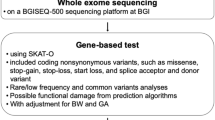Abstract
Background
Recently, it has been reported that genetic polymorphism (−634 G→C and −460 C→T) in the promoter region of the vascular endothelial growth factor (VEGF) gene can influence the progression of retinopathy of prematurity (ROP). In order to evaluate its general applicability as a screening procedure in clinics and to replicate the above result, we have undertaken the following study.
Methods
We have analyzed a cohort of 61 patients with advanced ROP (stage 4 and 5) along with 61 normal controls for the VEGF gene promoter polymorphism. For this purpose, blood samples were collected from each patient and leukocyte DNA was isolated. Genomic DNA was amplified by the polymerase chain reaction (PCR) method with two pairs of primers designed to amplify separately the promoter region (containing −634 G→C and −460 C→T polymorphism) of the VEGF gene. The amplified product was subjected to restriction enzyme digestion. The base change in the restriction site was further confirmed by a BigDye terminator cycle sequencing of the amplified product.
Results
Our analysis suggests that there is no significant difference in allelic frequency of the VEGF gene between normal subjects and patients with advanced ROP in our cohort.
Conclusion
Our results do not support the association of the VEGF gene promoter polymorphism and the risk of advanced ROP. In order to adapt this method for the identification of high-risk infants in clinics in the future, a large-scale study involving a mixed ethnically diverse population is much needed.
Similar content being viewed by others
References
Mechoulam H, Pierce EA (2003) Retinopathy of prematurity. Am J Pharmacogenomics 3:261–277
Reynolds JD, Hardy RJ, Kennedy KA, Spencer R, van Heuven WA, Fielder AR (1998) Lack of efficacy of light reduction in preventing retinopathy of prematurity. N Engl J Med 338:1572–1576
Aiello LP (1996) Vascular endothelial growth factor and the eye. Arch Ophthalmol 114:1252–1253
Amin RH, Frank RN, Kennedy A, Eliott D, Puklin JE, Abrams GW (1997) Vascular endothelial growth factor is present in glial cells of the retina and optic nerve of human subjects with nonproliferative diabetic retinopathy. Invest Ophthalmol Vis Sci 38:36–47
Hutcheson KA, Paluru PC, Bernstein SL, Koh J, Rappaport EF, Leach RA, Young TL (2005) Norrie disease gene sequence variants in an ethnically diverse population with retinopathy of prematurity. Mol Vis 11:501–508
Cooke RW, Drury JA, Mountford R, Clark D (2004) Genetic polymorphisms and retinopathy of prematurity. Invest Ophthalmol Vis Sci 45:1712–1715
Vannay AV, Dunai G, Banyasz I, Szabo M, Vamos R, Treszl A, Hajdu J, Tulassay T, Vasarhel YI (2005) Association of genetic polymorphisms of vascular endothelial growth factor and risk of proliferative retinopathy prematurity. Pediatr Res 57:396–398
Watson CJ, Webb NJ, Bottomley MJ, Brenchley PE (2000) Identification of polymorphisms within the vascular endothelial growth factor gene (VEGF): correlation with variation in VEGF protein production. Cytokine 12:1232–1235
Kwinta P, Mitkowska Z, Tomasik T, Bik-Multanowski M, Pietrzyk JJ (2004) Vascular endothelial growth factor gene polymorphism and the risk of retinopathy of prematurity. Pediatr Res 56:488
Acknowledgments
I would like to thank Dr. Michael T. Trese of William Beaumont Hospital and the patients and their parents who donated blood samples. This work was supported in part by the Oakland University Research Excellence Program in Biotechnology.
Author information
Authors and Affiliations
Corresponding author
Rights and permissions
About this article
Cite this article
Shastry, B.S., Qu, X. Lack of association of the VEGF gene promoter (−634 G→C and −460 C→T) polymorphism and the risk of advanced retinopathy of prematurity. Graefe's Arch Clin Exp Ophthalmol 245, 741–743 (2007). https://doi.org/10.1007/s00417-006-0480-6
Received:
Revised:
Accepted:
Published:
Issue Date:
DOI: https://doi.org/10.1007/s00417-006-0480-6




